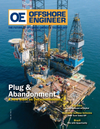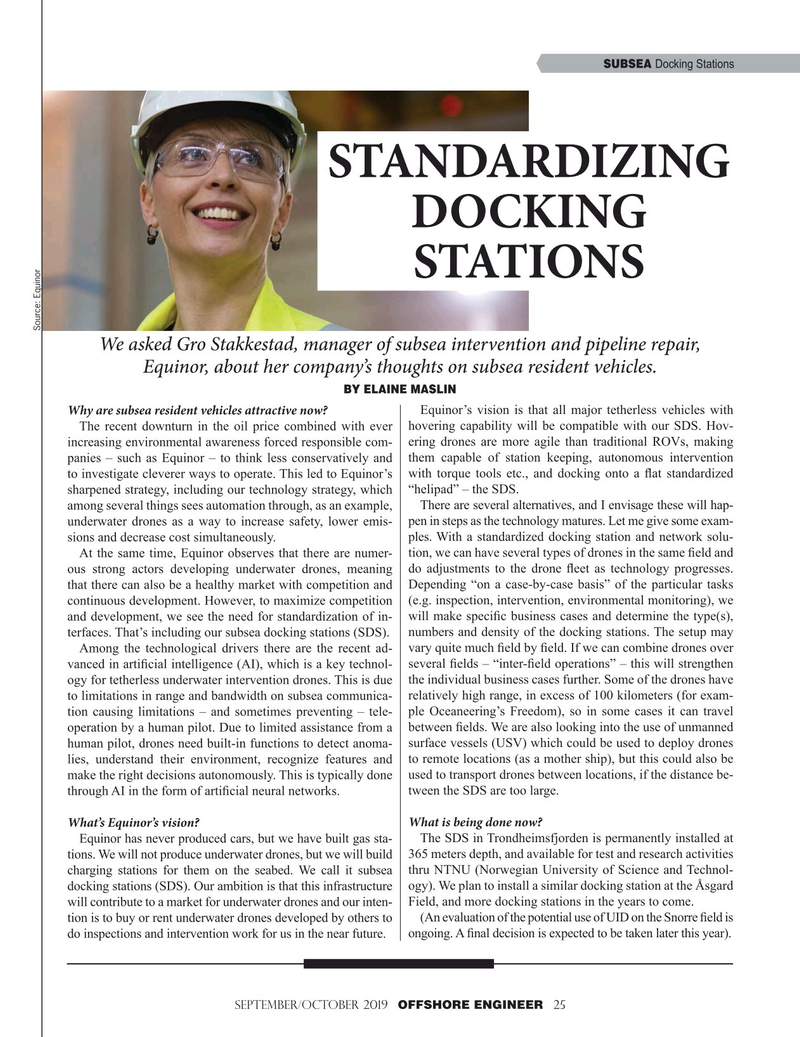
Page 25: of Offshore Engineer Magazine (Sep/Oct 2019)
Big Data and Digitalization
Read this page in Pdf, Flash or Html5 edition of Sep/Oct 2019 Offshore Engineer Magazine
SUBSEA Docking Stations
STANDARDIZING
DOCKING
STATIONS
Source: Equinor
We asked Gro Stakkestad, manager of subsea intervention and pipeline repair,
Equinor, about her company’s thoughts on subsea resident vehicles.
BY ELAINE MASLIN
Why are subsea resident vehicles attractive now? Equinor’s vision is that all major tetherless vehicles with
The recent downturn in the oil price combined with ever hovering capability will be compatible with our SDS. Hov- increasing environmental awareness forced responsible com- ering drones are more agile than traditional ROVs, making panies – such as Equinor – to think less conservatively and them capable of station keeping, autonomous intervention to investigate cleverer ways to operate. This led to Equinor’s with torque tools etc., and docking onto a ? at standardized sharpened strategy, including our technology strategy, which “helipad” – the SDS.
among several things sees automation through, as an example, There are several alternatives, and I envisage these will hap- underwater drones as a way to increase safety, lower emis- pen in steps as the technology matures. Let me give some exam- sions and decrease cost simultaneously. ples. With a standardized docking station and network solu-
At the same time, Equinor observes that there are numer- tion, we can have several types of drones in the same ? eld and ous strong actors developing underwater drones, meaning do adjustments to the drone ? eet as technology progresses. that there can also be a healthy market with competition and Depending “on a case-by-case basis” of the particular tasks continuous development. However, to maximize competition (e.g. inspection, intervention, environmental monitoring), we and development, we see the need for standardization of in- will make speci? c business cases and determine the type(s), terfaces. That’s including our subsea docking stations (SDS). numbers and density of the docking stations. The setup may
Among the technological drivers there are the recent ad- vary quite much ? eld by ? eld. If we can combine drones over vanced in arti? cial intelligence (AI), which is a key technol- several ? elds – “inter-? eld operations” – this will strengthen ogy for tetherless underwater intervention drones. This is due the individual business cases further. Some of the drones have to limitations in range and bandwidth on subsea communica- relatively high range, in excess of 100 kilometers (for exam- tion causing limitations – and sometimes preventing – tele- ple Oceaneering’s Freedom), so in some cases it can travel operation by a human pilot. Due to limited assistance from a between ? elds. We are also looking into the use of unmanned human pilot, drones need built-in functions to detect anoma- surface vessels (USV) which could be used to deploy drones lies, understand their environment, recognize features and to remote locations (as a mother ship), but this could also be make the right decisions autonomously. This is typically done used to transport drones between locations, if the distance be- through AI in the form of arti? cial neural networks. tween the SDS are too large.
What’s Equinor’s vision? What is being done now?
Equinor has never produced cars, but we have built gas sta- The SDS in Trondheimsfjorden is permanently installed at tions. We will not produce underwater drones, but we will build 365 meters depth, and available for test and research activities charging stations for them on the seabed. We call it subsea thru NTNU (Norwegian University of Science and Technol- docking stations (SDS). Our ambition is that this infrastructure ogy). We plan to install a similar docking station at the Åsgard will contribute to a market for underwater drones and our inten- Field, and more docking stations in the years to come. tion is to buy or rent underwater drones developed by others to (An evaluation of the potential use of UID on the Snorre ? eld is do inspections and intervention work for us in the near future. ongoing. A ? nal decision is expected to be taken later this year).
September/OctoBER 2019 OFFSHORE ENGINEER 25

 24
24

 26
26